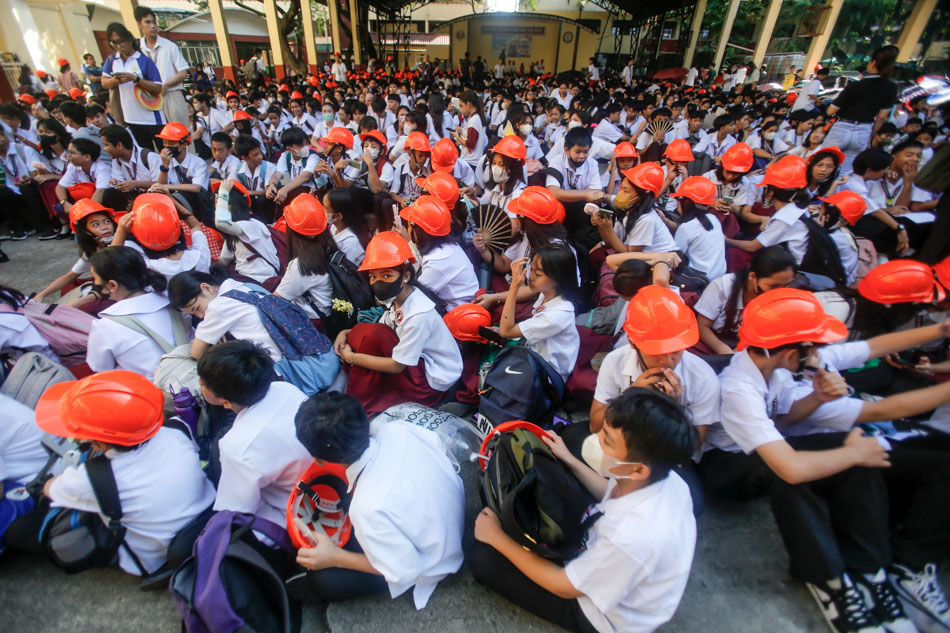Timing of recent successive quakes a coincidence, says Phivolcs | ABS-CBN

Welcome, Kapamilya! We use cookies to improve your browsing experience. Continuing to use this site means you agree to our use of cookies. Tell me more!
Timing of recent successive quakes a coincidence, says Phivolcs
Timing of recent successive quakes a coincidence, says Phivolcs
ABS-CBN News
Published Dec 06, 2023 10:49 AM PHT
|
Updated Dec 06, 2023 11:00 AM PHT
MANILA — The timing of a string of powerful quakes that recently rattled parts of the country was a “coincidence”, the Philippine Institute of Volcanology and Seismology (Phivolcs) said on Wednesday.
MANILA — The timing of a string of powerful quakes that recently rattled parts of the country was a “coincidence”, the Philippine Institute of Volcanology and Seismology (Phivolcs) said on Wednesday.
A magnitude 5.7 earthquake shook Metro Manila on Tuesday, sending people rushing out of buildings and briefly halting train services in the city.
It comes following aftershocks triggered by a magnitude 7.4 quake late Saturday in Mindanao that briefly triggered a tsunami warning.
A magnitude 5.7 earthquake shook Metro Manila on Tuesday, sending people rushing out of buildings and briefly halting train services in the city.
It comes following aftershocks triggered by a magnitude 7.4 quake late Saturday in Mindanao that briefly triggered a tsunami warning.
Asked why quake appeared to be occurring successively, Phivolcs Director Dr. Teresito Bacolcol said, “Nagkataon lang po ‘yan.”
Asked why quake appeared to be occurring successively, Phivolcs Director Dr. Teresito Bacolcol said, “Nagkataon lang po ‘yan.”
“Ibig lang pong sabihin, the Philippines is tectonically active. We have 6 trenches and 175 active fault segments. There is always the possibility po na sabay-sabay po ‘yan o magkakasunod po yung paglindol,” he told TeleRadyo Serbisyo.
“Ibig lang pong sabihin, the Philippines is tectonically active. We have 6 trenches and 175 active fault segments. There is always the possibility po na sabay-sabay po ‘yan o magkakasunod po yung paglindol,” he told TeleRadyo Serbisyo.
ADVERTISEMENT
Tuesday’s quake struck off Occidental Mindoro at 4:23 p.m., about 94 kilometers southwest of Manila.
Tuesday’s quake struck off Occidental Mindoro at 4:23 p.m., about 94 kilometers southwest of Manila.
“Hindi po ito prelude to the Big One,” Bacolcol said.
“Hindi po ito prelude to the Big One,” Bacolcol said.
The Big One is a potentially destructive quake that would come from the West Valley Fault.
The Big One is a potentially destructive quake that would come from the West Valley Fault.
It has “nothing to do with” the Manila trench that triggered Tuesday’s quake, Bacolcol said.
It has “nothing to do with” the Manila trench that triggered Tuesday’s quake, Bacolcol said.
The West Valley Fault stretches from Bulacan to Laguna and passes through the capital. The Big One could produce an intensity 8 shaking that would make even standing up difficult in Metro Manila, Bulacan, western parts of Rizal, and northern parts of Laguna and Cavite, Phivolcs earlier said.
The West Valley Fault stretches from Bulacan to Laguna and passes through the capital. The Big One could produce an intensity 8 shaking that would make even standing up difficult in Metro Manila, Bulacan, western parts of Rizal, and northern parts of Laguna and Cavite, Phivolcs earlier said.
Meanwhile, the 7.4-magnitude earthquake that shook eastern Mindanao on Dec. 2 has spawned 3,039 aftershocks as of 8 a.m. Its strongest aftershock was measured at magnitude 6.6, Bacolcol said.
Meanwhile, the 7.4-magnitude earthquake that shook eastern Mindanao on Dec. 2 has spawned 3,039 aftershocks as of 8 a.m. Its strongest aftershock was measured at magnitude 6.6, Bacolcol said.
At least three people were killed and 17 were injured after the Dec. 2 quake hit, with thousands still in evacuation centers.
At least three people were killed and 17 were injured after the Dec. 2 quake hit, with thousands still in evacuation centers.
Earthquakes are a daily occurrence in the Philippines, which sits along the Pacific "Ring of Fire", an arc of intense seismic and volcanic activity that stretches from Japan through Southeast Asia and across the Pacific basin.
Earthquakes are a daily occurrence in the Philippines, which sits along the Pacific "Ring of Fire", an arc of intense seismic and volcanic activity that stretches from Japan through Southeast Asia and across the Pacific basin.
— With a report from Agence France-Presse
ADVERTISEMENT
ADVERTISEMENT


